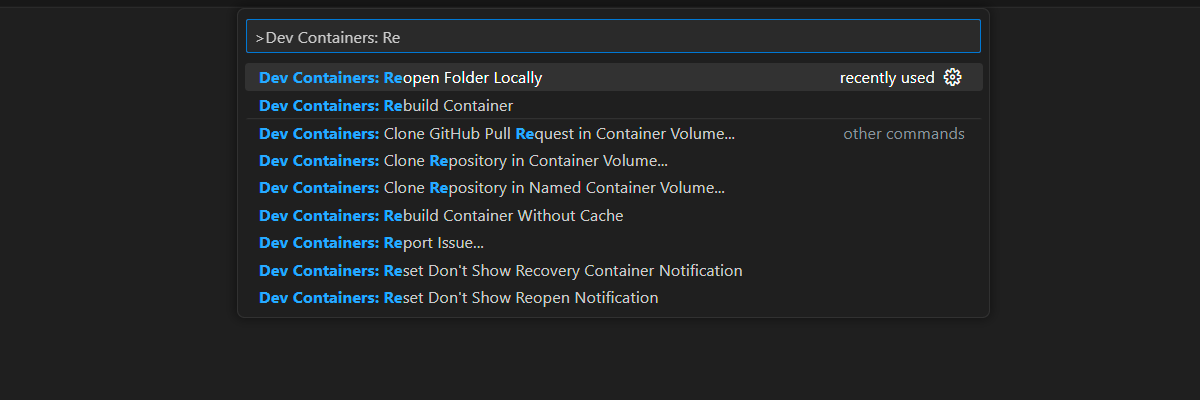Get started with evaluating answers in a chat app in JavaScript
This article shows you how to evaluate a chat app's answers against a set of correct or ideal answers (known as ground truth). Whenever you change your chat application in a way that affects the answers, run an evaluation to compare the changes. This demo application offers tools that you can use today to make it easier to run evaluations.
By following the instructions in this article, you:
- Use provided sample prompts tailored to the subject domain. These prompts are already in the repository.
- Generate sample user questions and ground truth answers from your own documents.
- Run evaluations by using a sample prompt with the generated user questions.
- Review analysis of answers.
Note
This article uses one or more AI app templates as the basis for the examples and guidance in the article. AI app templates provide you with well-maintained reference implementations that are easy to deploy. They help to ensure a high-quality starting point for your AI apps.
Architectural overview
Key components of the architecture include:
- Azure-hosted chat app: The chat app runs in Azure App Service.
- Microsoft AI Chat Protocol: The protocol provides standardized API contracts across AI solutions and languages. The chat app conforms to the Microsoft AI Chat Protocol, which allows the evaluations app to run against any chat app that conforms to the protocol.
- Azure AI Search: The chat app uses Azure AI Search to store the data from your own documents.
- Sample questions generator: The tool can generate many questions for each document along with the ground truth answer. The more questions there are, the longer the evaluation.
- Evaluator: The tool runs sample questions and prompts against the chat app and returns the results.
- Review tool: The tool reviews the results of the evaluations.
- Diff tool: The tool compares the answers between evaluations.
When you deploy this evaluation to Azure, the Azure OpenAI Service endpoint is created for the GPT-4 model with its own capacity. When you evaluate chat applications, it's important that the evaluator has its own Azure OpenAI resource by using GPT-4 with its own capacity.
Prerequisites
Azure subscription. Create one for free
Deploy a chat app.
These chat apps load the data into the Azure AI Search resource. This resource is required for the evaluations app to work. Don't complete the Clean up resources section of the previous procedure.
You need the following Azure resource information from that deployment, which is referred to as the chat app in this article:
- Chat API URI: The service backend endpoint shown at the end of the
azd upprocess. - Azure AI Search. The following values are required:
- Resource name: The name of the Azure AI Search resource name, reported as
Search serviceduring theazd upprocess. - Index name: The name of the Azure AI Search index where your documents are stored. This can be found in the Azure portal for the Search service.
- Resource name: The name of the Azure AI Search resource name, reported as
The Chat API URL allows the evaluations to make requests through your backend application. The Azure AI Search information allows the evaluation scripts to use the same deployment as your backend, loaded with the documents.
Once you have this information collected, you shouldn't need to use the chat app development environment again. It's referred to later in this article several times to indicate how the chat app is used by the Evaluations app. Don't delete the chat app resources until you complete the entire procedure in this article.
- Chat API URI: The service backend endpoint shown at the end of the
A development container environment is available with all dependencies required to complete this article. You can run the development container in GitHub Codespaces (in a browser) or locally using Visual Studio Code.
- GitHub account
Open a development environment
Begin now with a development environment that has all the dependencies installed to complete this article. Arrange your monitor workspace so that you can see this documentation and the development environment at the same time.
This article was tested with the switzerlandnorth region for the evaluation deployment.
GitHub Codespaces runs a development container managed by GitHub with Visual Studio Code for the Web as the user interface. For the most straightforward development environment, use GitHub Codespaces so that you have the correct developer tools and dependencies preinstalled to complete this article.
Important
All GitHub accounts can use GitHub Codespaces for up to 60 hours free each month with two core instances. For more information, see GitHub Codespaces monthly included storage and core hours.
Start the process to create a new GitHub codespace on the
mainbranch of the Azure-Samples/ai-rag-chat-evaluator GitHub repository.To display the development environment and the documentation available at the same time, right-click the following button, and select Open link in new window.
On the Create codespace page, review the codespace configuration settings, and then select Create new codespace.
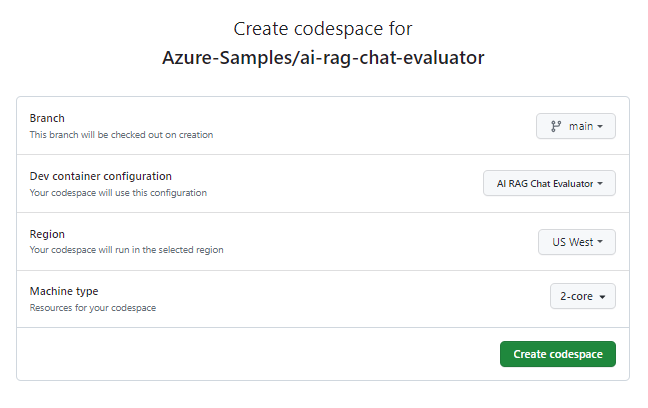
Wait for the codespace to start. This startup process can take a few minutes.
In the terminal at the bottom of the screen, sign in to Azure with the Azure Developer CLI:
azd auth login --use-device-codeCopy the code from the terminal and then paste it into a browser. Follow the instructions to authenticate with your Azure account.
Provision the required Azure resource, Azure OpenAI Service, for the evaluations app:
azd upThis
AZDcommand doesn't deploy the evaluations app, but it does create the Azure OpenAI resource with a requiredGPT-4deployment to run the evaluations in the local development environment.
The remaining tasks in this article take place in the context of this development container.
The name of the GitHub repository appears in the search bar. This visual indicator helps you distinguish the evaluations app from the chat app. This ai-rag-chat-evaluator repo is referred to as the evaluations app in this article.
Prepare environment values and configuration information
Update the environment values and configuration information with the information you gathered during Prerequisites for the evaluations app.
Create a
.envfile based on.env.sample.cp .env.sample .envRun this command to get the required values for
AZURE_OPENAI_EVAL_DEPLOYMENTandAZURE_OPENAI_SERVICEfrom your deployed resource group. Paste those values into the.envfile.azd env get-value AZURE_OPENAI_EVAL_DEPLOYMENT azd env get-value AZURE_OPENAI_SERVICEAdd the following values from the chat app for its Azure AI Search instance to the
.envfile, which you gathered in the Prerequisites section.AZURE_SEARCH_SERVICE="<service-name>" AZURE_SEARCH_INDEX="<index-name>"
Use the Microsoft AI Chat Protocol for configuration information
The chat app and the evaluations app both implement the Microsoft AI Chat Protocol specification, an open-source, cloud, and language-agnostic AI endpoint API contract that's used for consumption and evaluation. When your client and middle-tier endpoints adhere to this API specification, you can consistently consume and run evaluations on your AI backends.
Create a new file named
my_config.jsonand copy the following content into it:{ "testdata_path": "my_input/qa.jsonl", "results_dir": "my_results/experiment<TIMESTAMP>", "target_url": "http://localhost:50505/chat", "target_parameters": { "overrides": { "top": 3, "temperature": 0.3, "retrieval_mode": "hybrid", "semantic_ranker": false, "prompt_template": "<READFILE>my_input/prompt_refined.txt", "seed": 1 } } }The evaluation script creates the
my_resultsfolder.The
overridesobject contains any configuration settings that are needed for the application. Each application defines its own set of settings properties.Use the following table to understand the meaning of the settings properties that are sent to the chat app.
Settings property Description semantic_rankerWhether to use semantic ranker, a model that reranks search results based on semantic similarity to the user's query. We disable it for this tutorial to reduce costs. retrieval_modeThe retrieval mode to use. The default is hybrid.temperatureThe temperature setting for the model. The default is 0.3.topThe number of search results to return. The default is 3.prompt_templateAn override of the prompt used to generate the answer based on the question and search results. seedThe seed value for any calls to GPT models. Setting a seed results in more consistent results across evaluations. Change the
target_urlvalue to the URI value of your chat app, which you gathered in the Prerequisites section. The chat app must conform to the chat protocol. The URI has the following format:https://CHAT-APP-URL/chat. Make sure the protocol and thechatroute are part of the URI.
Generate sample data
To evaluate new answers, they must be compared to a ground truth answer, which is the ideal answer for a particular question. Generate questions and answers from documents that are stored in Azure AI Search for the chat app.
Copy the
example_inputfolder into a new folder namedmy_input.In a terminal, run the following command to generate the sample data:
python -m evaltools generate --output=my_input/qa.jsonl --persource=2 --numquestions=14
The question-and-answer pairs are generated and stored in my_input/qa.jsonl (in JSONL format) as input to the evaluator that's used in the next step. For a production evaluation, you would generate more question-and-answer pairs. More than 200 are generated for this dataset.
Note
Ony a few questions and answers are generated per source so that you can quickly complete this procedure. It isn't meant to be a production evaluation, which should have more questions and answers per source.
Run the first evaluation with a refined prompt
Edit the
my_config.jsonconfiguration file properties.Property New value results_dirmy_results/experiment_refinedprompt_template<READFILE>my_input/prompt_refined.txtThe refined prompt is specific about the subject domain.
If there isn't enough information below, say you don't know. Do not generate answers that don't use the sources below. If asking a clarifying question to the user would help, ask the question. Use clear and concise language and write in a confident yet friendly tone. In your answers, ensure the employee understands how your response connects to the information in the sources and include all citations necessary to help the employee validate the answer provided. For tabular information, return it as an html table. Do not return markdown format. If the question is not in English, answer in the language used in the question. Each source has a name followed by a colon and the actual information. Always include the source name for each fact you use in the response. Use square brackets to reference the source, e.g. [info1.txt]. Don't combine sources, list each source separately, e.g. [info1.txt][info2.pdf].In a terminal, run the following command to run the evaluation:
python -m evaltools evaluate --config=my_config.json --numquestions=14This script created a new experiment folder in
my_results/with the evaluation. The folder contains the results of the evaluation.File name Description config.jsonA copy of the configuration file used for the evaluation. evaluate_parameters.jsonThe parameters used for the evaluation. Similar to config.jsonbut includes other metadata like time stamp.eval_results.jsonlEach question and answer, along with the GPT metrics for each question-and-answer pair. summary.jsonThe overall results, like the average GPT metrics.
Run the second evaluation with a weak prompt
Edit the
my_config.jsonconfiguration file properties.Property New value results_dirmy_results/experiment_weakprompt_template<READFILE>my_input/prompt_weak.txtThat weak prompt has no context about the subject domain.
You are a helpful assistant.In a terminal, run the following command to run the evaluation:
python -m evaltools evaluate --config=my_config.json --numquestions=14
Run the third evaluation with a specific temperature
Use a prompt that allows for more creativity.
Edit the
my_config.jsonconfiguration file properties.Existing Property New value Existing results_dirmy_results/experiment_ignoresources_temp09Existing prompt_template<READFILE>my_input/prompt_ignoresources.txtNew temperature0.9The default
temperatureis 0.7. The higher the temperature, the more creative the answers.The
ignoreprompt is short.Your job is to answer questions to the best of your ability. You will be given sources but you should IGNORE them. Be creative!The configuration object should look like the following example, except that you replaced
results_dirwith your path:{ "testdata_path": "my_input/qa.jsonl", "results_dir": "my_results/prompt_ignoresources_temp09", "target_url": "https://YOUR-CHAT-APP/chat", "target_parameters": { "overrides": { "temperature": 0.9, "semantic_ranker": false, "prompt_template": "<READFILE>my_input/prompt_ignoresources.txt" } } }In a terminal, run the following command to run the evaluation:
python -m evaltools evaluate --config=my_config.json --numquestions=14
Review the evaluation results
You performed three evaluations based on different prompts and app settings. The results are stored in the my_results folder. Review how the results differ based on the settings.
Use the review tool to see the results of the evaluations.
python -m evaltools summary my_resultsThe results look something like:

Each value is returned as a number and a percentage.
Use the following table to understand the meaning of the values.
Value Description Groundedness Checks how well the model's responses are based on factual, verifiable information. A response is considered grounded if it's factually accurate and reflects reality. Relevance Measures how closely the model's responses align with the context or the prompt. A relevant response directly addresses the user's query or statement. Coherence Checks how logically consistent the model's responses are. A coherent response maintains a logical flow and doesn't contradict itself. Citation Indicates if the answer was returned in the format requested in the prompt. Length Measures the length of the response. The results should indicate that all three evaluations had high relevance while the
experiment_ignoresources_temp09had the lowest relevance.Select the folder to see the configuration for the evaluation.
Enter Ctrl + C to exit the app and return to the terminal.
Compare the answers
Compare the returned answers from the evaluations.
Select two of the evaluations to compare, and then use the same review tool to compare the answers.
python -m evaltools diff my_results/experiment_refined my_results/experiment_ignoresources_temp09Review the results. Your results might vary.
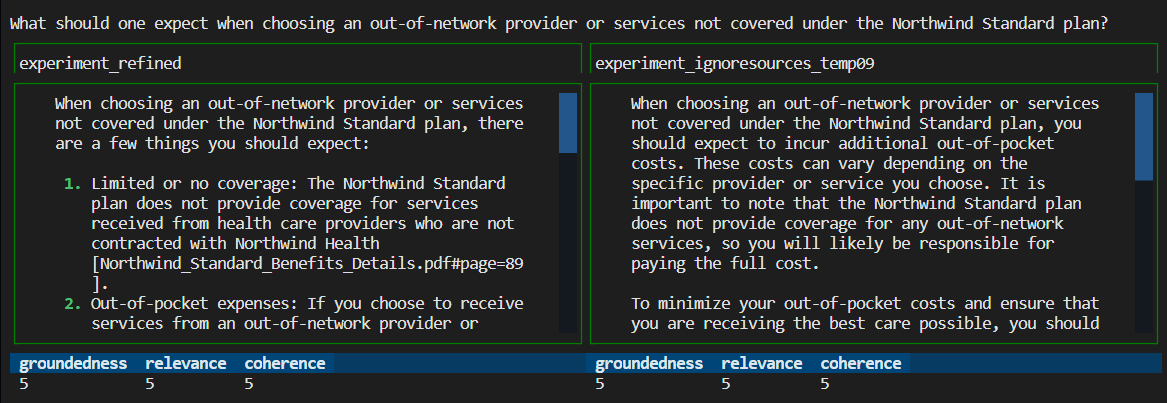
Enter Ctrl + C to exit the app and return to the terminal.
Suggestions for further evaluations
- Edit the prompts in
my_inputto tailor the answers such as subject domain, length, and other factors. - Edit the
my_config.jsonfile to change the parameters such astemperature, andsemantic_rankerand rerun experiments. - Compare different answers to understand how the prompt and question affect the answer quality.
- Generate a separate set of questions and ground truth answers for each document in the Azure AI Search index. Then rerun the evaluations to see how the answers differ.
- Alter the prompts to indicate shorter or longer answers by adding the requirement to the end of the prompt. An example is
Please answer in about 3 sentences.
Clean up resources and dependencies
The following steps walk you through the process of cleaning up the resources you used.
Clean up Azure resources
The Azure resources created in this article are billed to your Azure subscription. If you don't expect to need these resources in the future, delete them to avoid incurring more charges.
To delete the Azure resources and remove the source code, run the following Azure Developer CLI command:
azd down --purge
Clean up GitHub Codespaces and Visual Studio Code
Deleting the GitHub Codespaces environment ensures that you can maximize the amount of free per-core hours entitlement that you get for your account.
Important
For more information about your GitHub account's entitlements, see GitHub Codespaces monthly included storage and core hours.
Sign in to the GitHub Codespaces dashboard.
Locate your currently running codespaces that are sourced from the Azure-Samples/ai-rag-chat-evaluator GitHub repository.
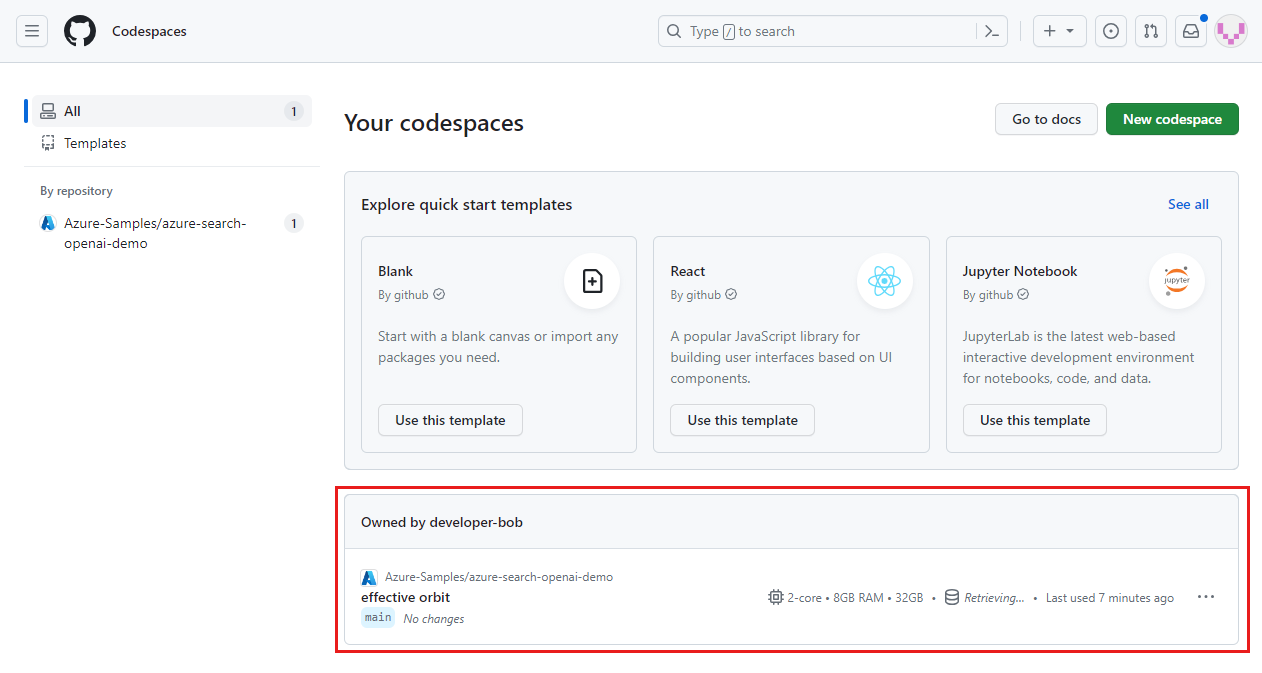
Open the context menu for the codespace, and then select Delete.
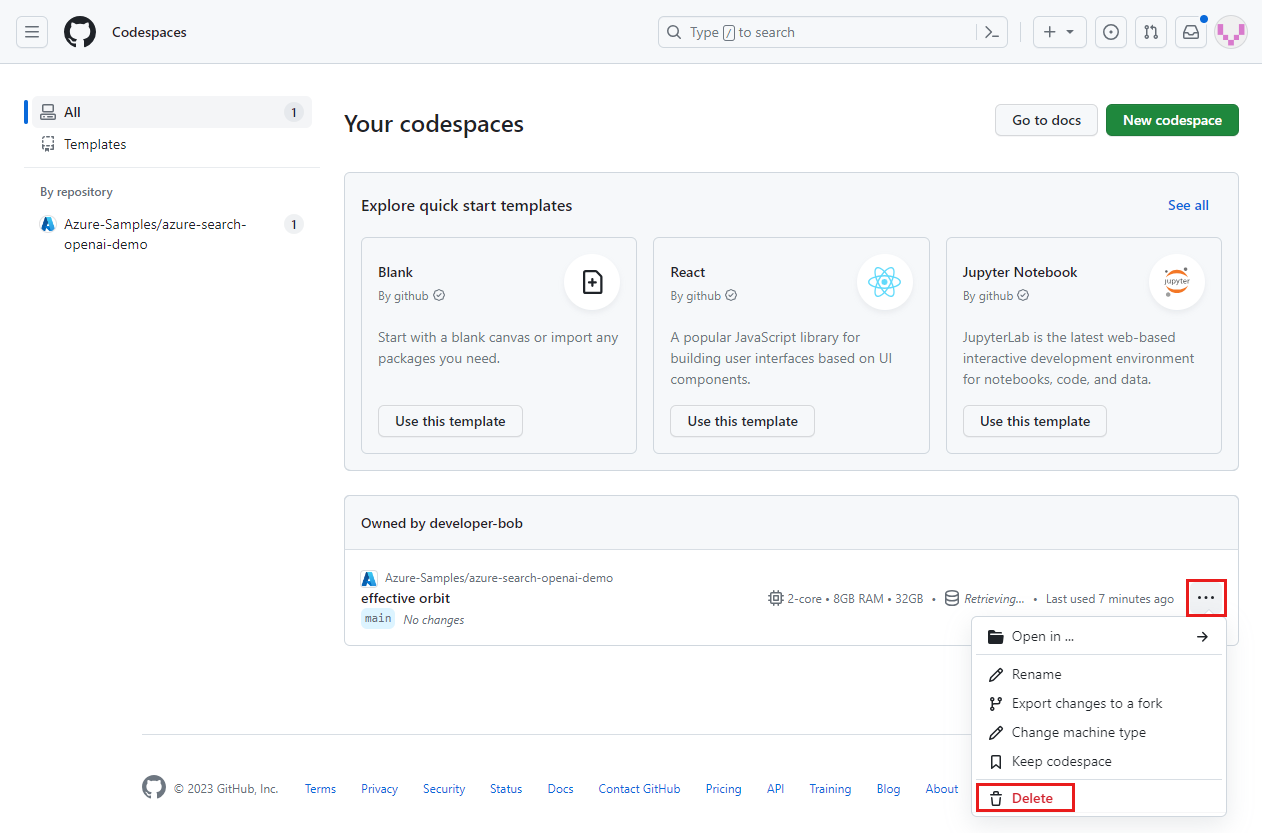
Return to the chat app article to clean up those resources.
Related content
- See the evaluations repository.
- See the enterprise chat app GitHub repository.
- Build a chat app with Azure OpenAI best-practices solution architecture.
- Learn about access control in generative AI apps with Azure AI Search.
- Build an enterprise-ready Azure OpenAI solution with Azure API Management.
- See Azure AI Search: Outperforming vector search with hybrid retrieval and ranking capabilities.

